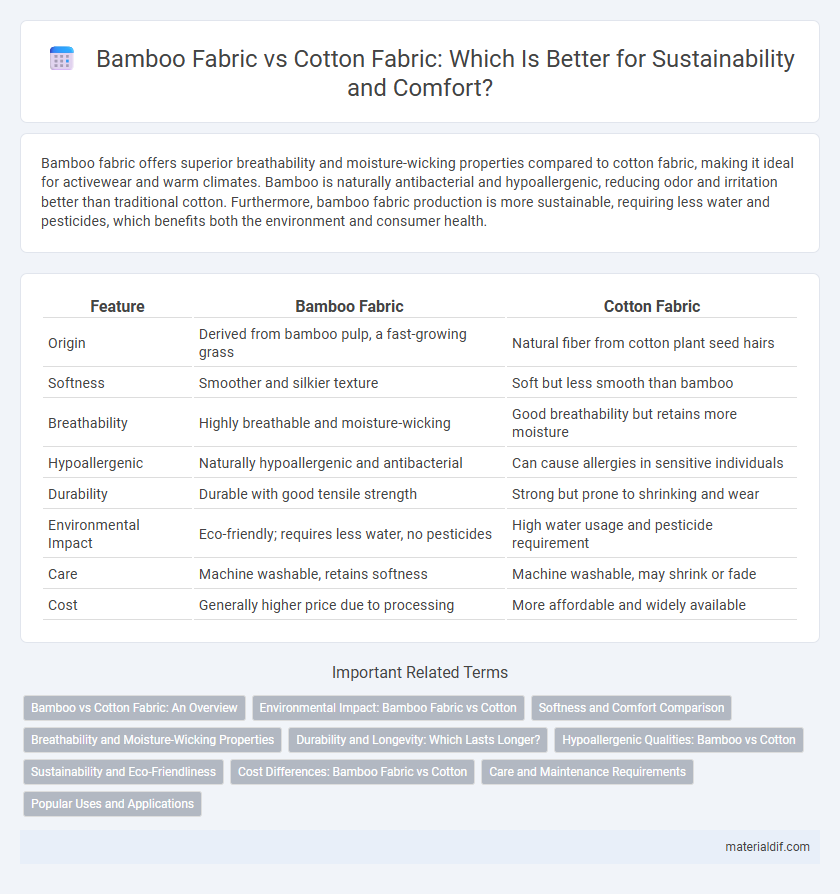Bamboo fabric offers superior breathability and moisture-wicking properties compared to cotton fabric, making it ideal for activewear and warm climates. Bamboo is naturally antibacterial and hypoallergenic, reducing odor and irritation better than traditional cotton. Furthermore, bamboo fabric production is more sustainable, requiring less water and pesticides, which benefits both the environment and consumer health.
Table of Comparison
| Feature | Bamboo Fabric | Cotton Fabric |
|---|---|---|
| Origin | Derived from bamboo pulp, a fast-growing grass | Natural fiber from cotton plant seed hairs |
| Softness | Smoother and silkier texture | Soft but less smooth than bamboo |
| Breathability | Highly breathable and moisture-wicking | Good breathability but retains more moisture |
| Hypoallergenic | Naturally hypoallergenic and antibacterial | Can cause allergies in sensitive individuals |
| Durability | Durable with good tensile strength | Strong but prone to shrinking and wear |
| Environmental Impact | Eco-friendly; requires less water, no pesticides | High water usage and pesticide requirement |
| Care | Machine washable, retains softness | Machine washable, may shrink or fade |
| Cost | Generally higher price due to processing | More affordable and widely available |
Bamboo vs Cotton Fabric: An Overview
Bamboo fabric offers superior breathability and natural moisture-wicking properties compared to cotton fabric, making it ideal for activewear and sensitive skin. Bamboo fibers are naturally antibacterial and hypoallergenic, reducing odors and skin irritation more effectively than conventional cotton. Additionally, bamboo cultivation requires less water and fewer pesticides, positioning it as a more sustainable textile choice relative to cotton.
Environmental Impact: Bamboo Fabric vs Cotton
Bamboo fabric has a lower environmental impact than cotton due to its rapid growth and minimal need for pesticides or fertilizers, resulting in less soil depletion and water usage. Cotton cultivation requires substantially more water--up to 20,000 liters per kilogram of cotton--and heavy pesticide use, contributing to soil erosion and water pollution. Bamboo's natural biodegradability and sustainable harvesting methods further reduce its ecological footprint compared to conventional cotton farming.
Softness and Comfort Comparison
Bamboo fabric is inherently softer than cotton due to its micro-gauge fibers, offering a silky texture that enhances comfort against the skin. Its natural moisture-wicking properties keep the fabric breathable and cool, reducing irritation and making it ideal for sensitive skin. Cotton, while soft, tends to be less smooth and can retain moisture, which may lead to discomfort during prolonged wear.
Breathability and Moisture-Wicking Properties
Bamboo fabric exhibits superior breathability compared to cotton, allowing air to circulate more freely and keeping the wearer cooler in warm conditions. Its natural moisture-wicking properties efficiently draw sweat away from the skin, promoting quicker evaporation and enhanced comfort during physical activities. In contrast, cotton tends to retain moisture longer, which can lead to a damp feeling and reduced breathability.
Durability and Longevity: Which Lasts Longer?
Bamboo fabric exhibits superior durability compared to cotton, with a tensile strength that often withstands wear and tear longer under regular use. Its natural antimicrobial properties and resistance to UV light contribute to the fabric maintaining integrity and color retention over time, unlike cotton which tends to degrade faster with frequent washing. Bamboo's longevity makes it a more sustainable choice for clothing and home textiles, reducing the need for frequent replacements and supporting eco-friendly consumption.
Hypoallergenic Qualities: Bamboo vs Cotton
Bamboo fabric exhibits superior hypoallergenic qualities compared to cotton due to its natural antibacterial and antifungal properties, reducing the risk of skin irritation and allergies. Bamboo fibers are also moisture-wicking and breathable, fostering a dry environment that inhibits allergen growth, unlike conventional cotton, which can retain moisture and harbor bacteria. Studies indicate that bamboo fabric is ideal for sensitive skin and conditions like eczema, making it a preferred choice for hypoallergenic textiles.
Sustainability and Eco-Friendliness
Bamboo fabric is significantly more sustainable than cotton fabric due to its rapid growth rate and minimal need for pesticides or fertilizers, reducing environmental impact. Unlike cotton, which requires vast amounts of water for cultivation, bamboo thrives with natural rainfall, conserving water resources. Bamboo's biodegradability and renewable nature make it an eco-friendly textile choice for sustainable fashion and home products.
Cost Differences: Bamboo Fabric vs Cotton
Bamboo fabric typically costs more than cotton due to the more complex processing methods required to transform bamboo fibers into usable textile material. While cotton is widely cultivated and benefits from established large-scale farming and manufacturing infrastructure, bamboo production involves eco-friendly harvesting practices and chemical treatments that increase its price. Consumers opting for bamboo fabric pay a premium for its sustainability, softness, and hypoallergenic properties compared to the generally lower-cost, widely available cotton fabric.
Care and Maintenance Requirements
Bamboo fabric requires gentle washing in cold water and air drying to maintain its softness and durability, while cotton fabric can endure higher temperatures in washing and drying without significant damage. Bamboo's natural antibacterial properties reduce odor buildup, decreasing the need for frequent washes compared to cotton. Proper care of bamboo fabric extends its lifespan and preserves its silky texture, whereas improper handling of cotton can lead to shrinking and color fading.
Popular Uses and Applications
Bamboo fabric is popular in activewear, baby clothing, and eco-friendly bedding due to its natural antibacterial properties and moisture-wicking abilities, making it ideal for sensitive skin and humid climates. Cotton fabric remains widely used in casual wear, home textiles, and denim because of its durability, breathability, and ease of dyeing. Bamboo's sustainability advantages appeal to environmentally conscious consumers, while cotton's versatility maintains its status as a wardrobe staple.
bamboo fabric vs cotton fabric Infographic

 materialdif.com
materialdif.com